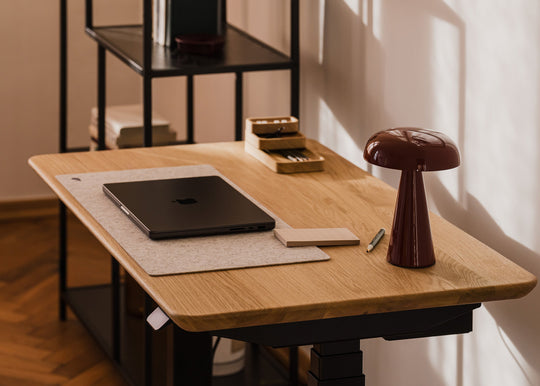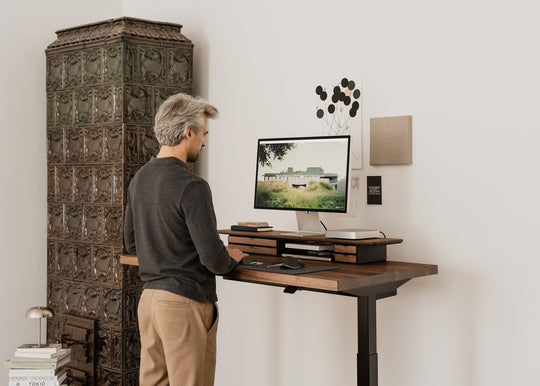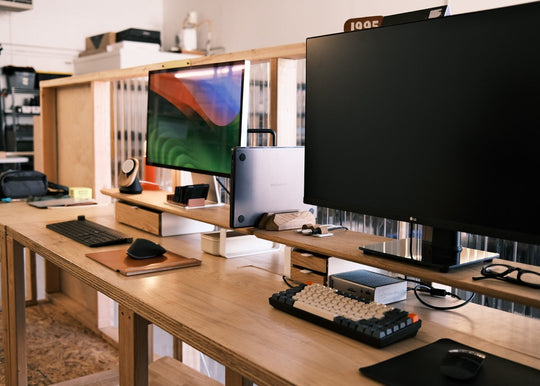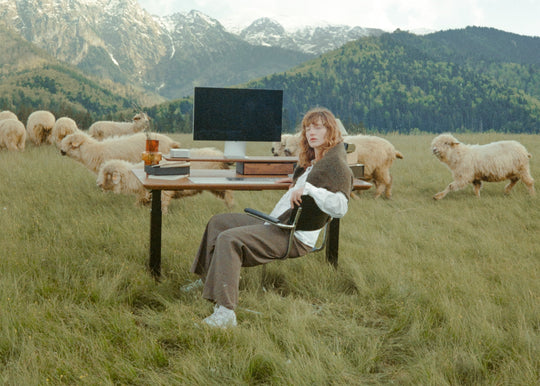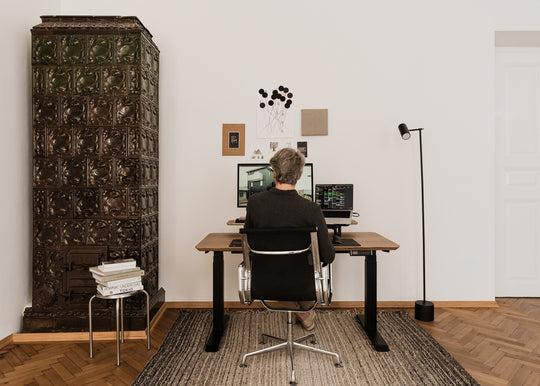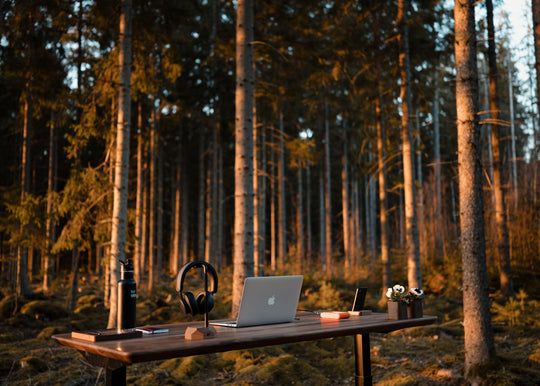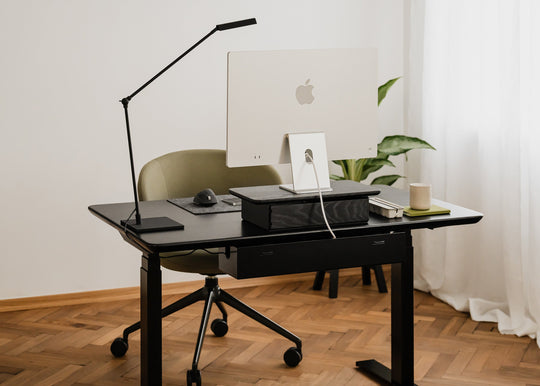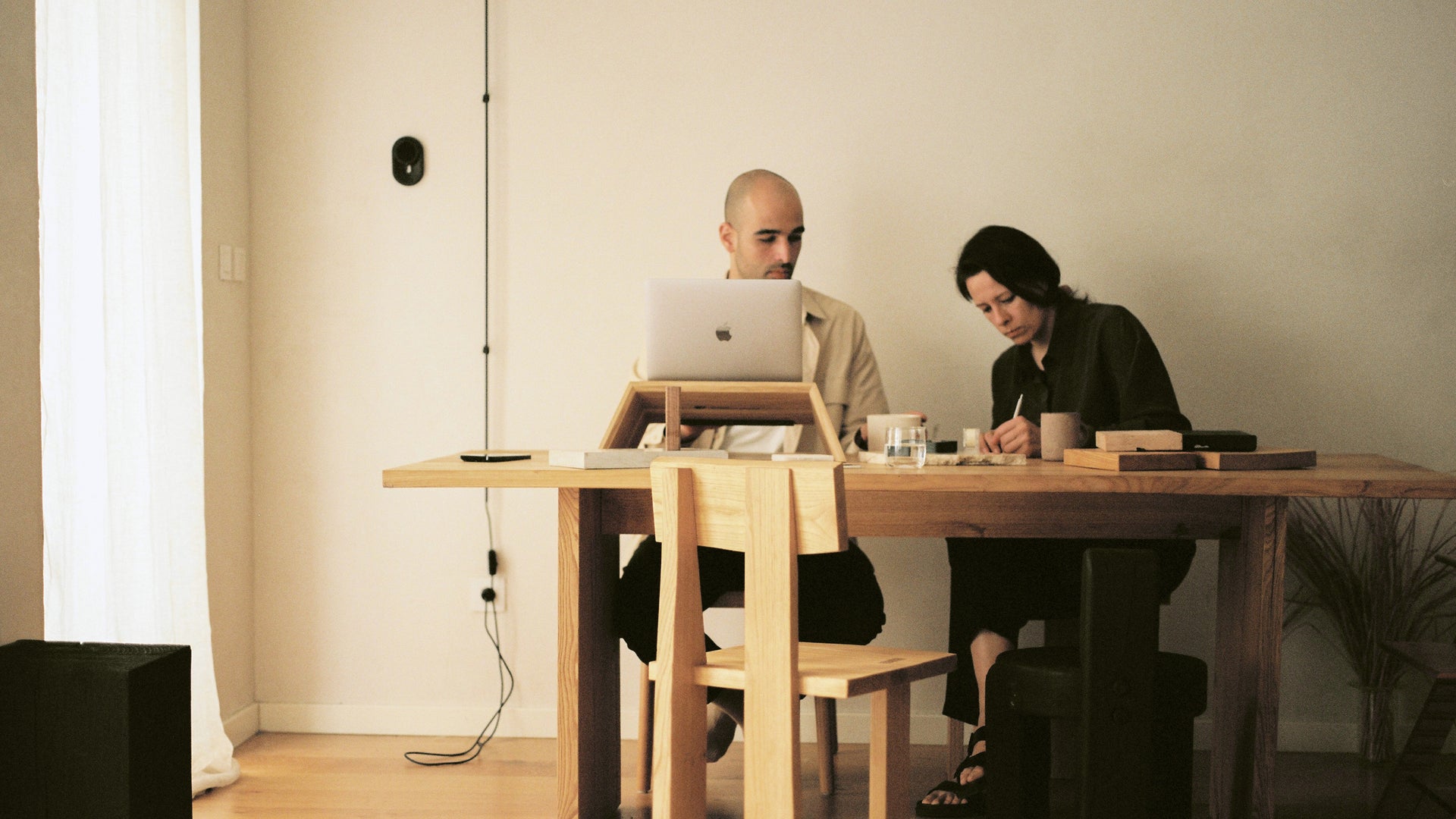
Creation is an intimate process. A conversation with Natasza and Tomas from THER
Imagine pondering the idea that everything on Earth possesses its own spirit—a notion that compels us to reconsider our relationship with the seemingly inanimate elements that surround us. Rocks, water, trees: could they be more than just passive components of our world? And what about the myriad materials that form the backbone of design? Could we, should we, tune in more closely to the stories they're yearning to tell?

This contemplation deeply resonated with me following our dialogue with Natasza and Tomas. Their eloquent reflections on their intimate work with wood and clay—materials that serve as the primary conduits for their creativity—left a profound impression. Through my mind's eye, I envisioned them with their materials: feeling the texture of the wood, observing its intricate patterns, embracing the process of discovery and being receptive to the journey ahead.
Our conversation took place in Lisbon, within the confines of their home—a quiet oasis that stands apart from the urban flurry. This space, a harmonious blend of living area, workshop, and showroom, seamlessly encapsulates their aesthetic and inspirations. Every corner, every detail, speaks volumes of their philosophy and approach to design, inviting one into a realm where every object tells a tale, urging us to listen more intently and observe more closely.
Zuza: Starting off, I'm curious about the story behind THER. Could you share how you both met and what sparked the beginning of your journey together?
Natasza: It’s a very funny story. So, we met at Domaine de Boisbuchet during a residency program. It's a unique place in France, run by very talented people. Before we even officially worked together, we were already collaborating on some projects within this design and architecture framework. It happened quite naturally. Tomas was a workshop technician, and I was part of the general staff for the summer workshop season. At the end of each month of volunteering I could participate in the workshop… It was clear from the start that our collaboration was inevitable.
Tomas: And, you were already telling me to cut things for you…
Natasza: It felt organic, and like everyone else, I didn’t receive any special treatment…(laughs) Our relationship and our first project took root in an environment that still influences us. Despite moving locations a couple of times over our seven-year relationship, the ethos of that initial setting remains with us. It’s been a journey of ups and downs, of change, especially notable as we transitioned into our next phase in Norway.
Wait, you met in France but then decided to move to Norway? What prompted that shift?
N: The move to Norway was a spontaneous decision. Tomas has always been drawn to the north, with no desire to live in the south.
Tomas, why were you so drawn to the north?
T: Maybe it's the lure of different scenery, you know? I've always had this deep interest in wooden construction, in Scandinavian architecture and design, and, well, the lifestyle that comes with it. It’s all about those principles we keep hearing about – like women's suffrage, equality, liberal politics – big on our list. Where we come from, titles like 'doctor' are a big deal, but in Norway, things feel more levelled. That’s kind of what drove us there; this egalitarian approach is just different.
And then there’s the architecture – buildings there, they’re like crafted in “gold” to us. So, the move wasn’t just about the scenery; it was about the professional opportunities, too. We ended up where we could both shine: Natasza in a bespoke ceramic studio and me in a carpentry company. We were designing and crafting, really getting our hands into the work.
It's interesting because we were working for these two companies that often collaborated on similar projects. Say, a restaurant needed furniture, that'd be my company's domain, including the design aspects. And Natasza, she'd be on the same project, but working on the ceramics. It made us realise, we’re not just dreaming the same dream; we actually have this chance to make it real, on our terms, you know? So, yeah, that's how it all played out.
So, it sounds like the dream for your brand began taking shape while you were honing your skills in Norway, right?
T: The brand idea evolved quite naturally. It felt like we were already on that path, albeit indirectly. The real challenge was that we were still working for others, which was the only constraint.
Was there a defining moment for you both, or did it just unfold over time?
N: It's very worth mentioning one thing, because it actually shapes our dynamics together, until this day. After running the brand for over four years, it all started one morning when I said to Tomas that I'm going to start producing some stuff and creating a label so we can showcase our style and also learn what is ours, what part of this is who we are, what we want. And I'm bringing a name, which is a really big thing. Tomas' first reaction was, 'Why? You can't do this. Isn’t that overproducing? Aren’t we supposed to work on bespoke projects? Why would you produce something when you don't even know if there's a need for it?”.
That pragmatism didn’t demotivate you, Natasza, I take it?
(Laughter)
T: No, it didn’t. We were exploring the balance between bespoke and spontaneous creation. I just questioned, "How can we attract bespoke projects if people aren't familiar with our work, our style, or the quality we offer?" It was a funny period, really. In Norway, we called this dynamic 'Spum'—a word we made up for the constant motivation to keep creating, despite the debates and doubts.

Can you pinpoint the moment when you started working solely on your brand? That must have been a significant milestone.
N: Absolutely. The real shift happened when we moved to Lisbon. In Norway, our space was limited, so investing in heavy, expensive tools wasn’t feasible. The move marked a new chapter, giving us the freedom to fully invest in and develop our brand without constraints.
T: We couldn't bring the materials we wanted to work with into Norway, or dive into carpentry like I wanted. We felt constrained. To really dive deep into our exploration, we knew we had to leave. It wasn’t about not liking our jobs or anything; it was about needing a different space to grow. And yes, I wanted more sun! After three years in the north, Natasza agreed. Portugal wasn't just a choice for the weather; it was strategic for being closer to our producers and the materials we wanted to explore.
So, moving was a natural step for you as designers.
N: Yes, once we decided on Portugal, we could finally buy the tools and machinery we needed. It felt like we were truly starting our journey, laying down our roots where we wanted to be.
Your motto 'we are what we explore' seems to capture your journey. How did it come about?
T: That motto is really about our approach to work and life. In Portugal, we wanted to deepen our connection with local materials, something we tried in Norway but were limited in variety. Here, we've been able to explore more freely, discovering new materials and techniques. It’s about pushing boundaries and seeing where each material can take us.
N: Exactly. Like yesterday during our visit to the local sawmill. Finding Portuguese ash out of the blue there, we never worked with it before but it didn't stop us from trying. It is a sort of a moment that really embodied that motto for us. It was a discovery that shaped our direction in an unplanned way.
T: Every material asks us, “What can be done with me?” – whether it’s wood, clay, or something else, we’re always in conversation with our materials. And it’s not just about us in our studio; it involves our partners too, like when we work with glass, textile or stone. We dive into the stories of these materials, their possibilities, and constraints.
N: Our work—and in a way, we ourselves—are shaped by these materials.
It's leading the way.
N: Yes, it's about understanding and exploring each material's potential. This exploration is central to our work, whether we're crafting ourselves or collaborating with others. It’s this exploration that defines us. And sometimes neither we nor the client are 100 percent sure about the precise final outcome.
(Laughs)
T: Our approach is broad because clients, while they commission us for pieces like sideboards, don't always know exactly what the final product will look like. They have inspirations and references, of course. Often during the process, we find ourselves contacting clients to suggest adjustments for better proportions, which they're usually open to. This means our studio doesn’t just prototype; we create in cycles. We build, evaluate, and adjust. It's an ongoing process of refinement, except for a few cases where multiple iterations lead us to the final design we love.
It’s about adapting as we go. For instance, our construction process is unlike prototyping with cardboard – it's real work from the start. Now, with experience, especially with tables, we know what variations we can explore. We don’t aim for complex joinery like Japanese craftsmen; our focus is on creating one off pieces that work well with our design ethos.
Clients must really buy into this approach.
T: What's beautiful now is attracting clients who appreciate our style, establishing a relationship based on trust. They expect a high-quality product that aligns with our unique style. This trust empowers us to explore even further, knowing that at the end of the day, our clients have faith in us. What could go wrong? Of course, we’ve had projects we had to redo, but error and failure are part of our learning process.

It's all a big lesson, then.
N: We’re open about our process, even joking with clients that the first version might end up in our house, so they get an improved version. As makers, we’re committed to delivering the best possible product. That's the foundation of our relationship with clients – trust.
I'm always intrigued when I talk with studios that have a clear division of skills and roles among co-founders. How does collaboration work for you?
N: It's really about balancing our contributions. Yes, our materials and methods might differ, but…
T: Right, when we get a commission, clients usually provide some references. We start by discussing these references and then, Natasza often sets the art direction based on an initial idea of volume. I'll then dive into refining this volume with a more technical skillset. It's a back-and-forth process where Natasza might adjust the direction, aiming to find a balance between my construction techniques and her aesthetic vision. We constantly check with each other if we’re on the right path or if significant changes are needed.
So, it's a continuous dialogue between you two.
N: Exactly, but what really enables our collaboration is our shared aesthetic. We're drawn to the same things, and our design voices are in harmony. When something doesn't feel right, we both sense it, even if we can't immediately pinpoint what it is. Being open to evolving our ideas is crucial, especially for bespoke projects. And because our workspaces, like the ceramic studio, are part of our home, inspiration can strike at any time, whether we're with our daughter, cooking, or even in the shower.
I was about to ask how you balance living and working in the same space…
N: Our work is deeply personal. If there's tension between us, it affects our cooperation. However, when things flow smoothly, we can accomplish intense work together. It's essential for us to maintain a good relationship, not just for our sake but for our work's quality. The crafting process varies; sometimes I finalise a piece, or Tomas does, depending on the project.
Our process may evolve, but our sync during the conception phase is constant. Execution might bring disagreements or challenges, like dealing with material failures, but these are part of the exploration. How we integrate our work and life varies; we might work separately then come together to discuss ideas, or find time to collaborate directly when our schedule allows. It's very fluid, reflecting the nature of our lives and partnership.
I've never asked this before, but I’m really curious about your inspirations. Are there any specific places, people, or books that drive your work?
N: We find inspiration in various places, but we both deeply resonate with Donald Judd's perspective. I gifted Tomas one of his books, which delves deep into his thought process and design philosophy. Judd's work might appear straightforward, but understanding his context and rationale reveals a depth beyond the simplicity. It's about looking beyond the surface, where a simple cube isn't just a cube once you grasp his perspective on design and creation.
T: We're also drawn to the contrast between simple forms and their underlying complexity, much like the work of Noguchi and other organic designs. Architectural elements greatly inspire us, alongside specific architectural collectives and their projects. Places like Louisiana in Denmark and Casa Wabi in Mexico have profoundly impacted us, leaving lasting impressions.
Additionally, Sebastian Cox's forestry-forward approach in the UK has shifted our perspective on material sourcing and responsibility. While the direct output of his work isn't the sole inspiration, his principles on sustainable forestry and material use resonate with us.

I find it interesting, Tomas, that you once thought you'd never come back to Portugal to live and work, considering your affinity for the North. Now that you're back in Lisbon, how do you feel? Does the city fuel your creativity? What's your relationship with Lisbon like now?
T: When we returned in 2021, the pandemic had just hit, and we saw how international Lisbon had become. It was a shift from the small northern town we were in, especially in terms of the diverse crowd and the burgeoning practices in the city. It wasn’t just about the craftsmanship or the ease of working with materials here but also the city’s energy. Coming here, I started seeing things from a fresh perspective, almost like a foreigner would, despite being Portuguese. After years in Norway, Lisbon feels different, even though I know the language and culture. It’s like rediscovering the city. There’s a lot here in terms of cultural values and international work. We're in a place that's evolving, and it feels right to be part of that progress.
It sounds like you've found your footing here.
T: Definitely. These three years have been valuable, not just for us but also for raising our daughter here. We've found a balance that suits our family and our lifestyle. Living in Lisbon allows us to focus intensely during the week and then escape to completely different settings in just 30 minutes. Portugal's diverse landscape offers this flexibility. It's hard to imagine being anywhere else.
Despite enjoying city life, lately, we find rejuvenation in leaving the city on weekends. Our recent spacious setup in Alentejo, a wood workshop and a studio at my grandparents' farm, has become a sanctuary for us. It offers a stark contrast to the city—there's either work or rest, with no in-between distractions. This environment sharpens our focus.
Lisbon's diversity and the creative community here are fantastic. Yet, we're also drawn to the calm and inspiration that comes from being in nature. This balance helps us recharge and explore new ideas. Our relationship with Lisbon is evolving—it's an appreciation that grows deeper, recognizing the city's role in our lives and work. But this duality, the need for contrasting experiences, is essential for our growth as individuals and creatives. Portugal's varied culture and landscapes enable us to push our artistic boundaries freely in many directions.
Since you both have unique preferences for the materials you work with, I'm interested in hearing about the beginnings of these passions. Natasza, could you share first how you were drawn to clay?
N: The interesting thing is, it was relatively late. Six months before my master degree finals, I went to Amsterdam for an internship. There, after a few weeks, my boss assigned me to make a porcelain prototype of a new project. He knew I had never worked with this material before, however he sensed that I would manage just fine…So the rest of my internship I spent in a Ceramic Workshop Center in s-Hertogenbosch on a residency to execute the designs.
I could use the facilities as long as I wanted so I find myself trying out a lot of stuff, from mould making, slip casting, press shaping, CNC in a raw clay and more. Unlimited possibilities and dedicated staff were all in with my ideas. Since then, I was hooked. That was the 2 months that made me want to work with this tricky, yet fulfilling material.

And you Tomas?
T: My father was essentially a designer by education and a self-taught carpenter. He produced bespoke furniture in the early '90s, which really influenced me growing up. Whenever I wanted something, like swords, he'd say, "Let's go to the workshop and make it." This hands-on approach from an early age taught me not just about working with wood but also about the creativity behind making something tangible.
It was this background that stayed with me, even as I ventured into engineering. However, I felt a disconnect with the theoretical aspects and was drawn back to the tangible process of creating with wood. This led me to shift my focus towards product design, seeking to understand not just how to make things, but why and the design thinking behind them.
You are often exploring unconventional woods? For example eucalyptus. Why?
T: We often use chestnut and pine, of course, but eucalyptus wood isn't commonly used in high-end, bespoke furniture. Especially the red variant of the species (Eucalyptus camaldulensis). Understanding how the sawmill processes this material and the reasons behind the felling of these trees, like cases we’ve seen of 100-plus-year-old red gum eucalyptus removed because they're obstructing roads— planted we grand purpose in the late 19th or early 20th century—we definitely feel it's our duty as makers and designers to be responsible and to pay attention to what is already there around us. These trees were often overlooked in carpentry, considered too hard to work with or prone to warping, partly because drying techniques weren't as advanced as they are now.
However, our focus on producing bespoke pieces on demand and in small quantities, allows us to deeply explore the entire journey of the materials we use, from how and where a tree was cut down to its transformation into a piece of furniture. This process includes sharing the story of a tree cut down due to a storm in 2017 and how it stood in a yard for years before being used. This narrative not only engages us but also instil a sense of responsibility towards using materials that are centuries old, emphasising the thoughtful choices we need to make in our work.
To me, it all sounds like you're navigating a complex landscape. Making things sustainably or as you said responsibly might be challenging…
N: Yes, it truly is. We do a lot of tests and experiments because our work often involves one-of-a-kind pieces. This process is humbling; it reveals how much there is to learn. Each project, whether it involves different types of wood, clays, firing methods, finishes, or design processes, teaches us something new.
The more we explore and experiment, the more we realise the depth of what we don't know. Yet, paradoxically, this journey of continuous learning also shows us how much we've grown in our knowledge and skills. It's an intriguing process—feeling like the more we do, the less we know, and yet, the more we understand. It's quite funny in a way.

